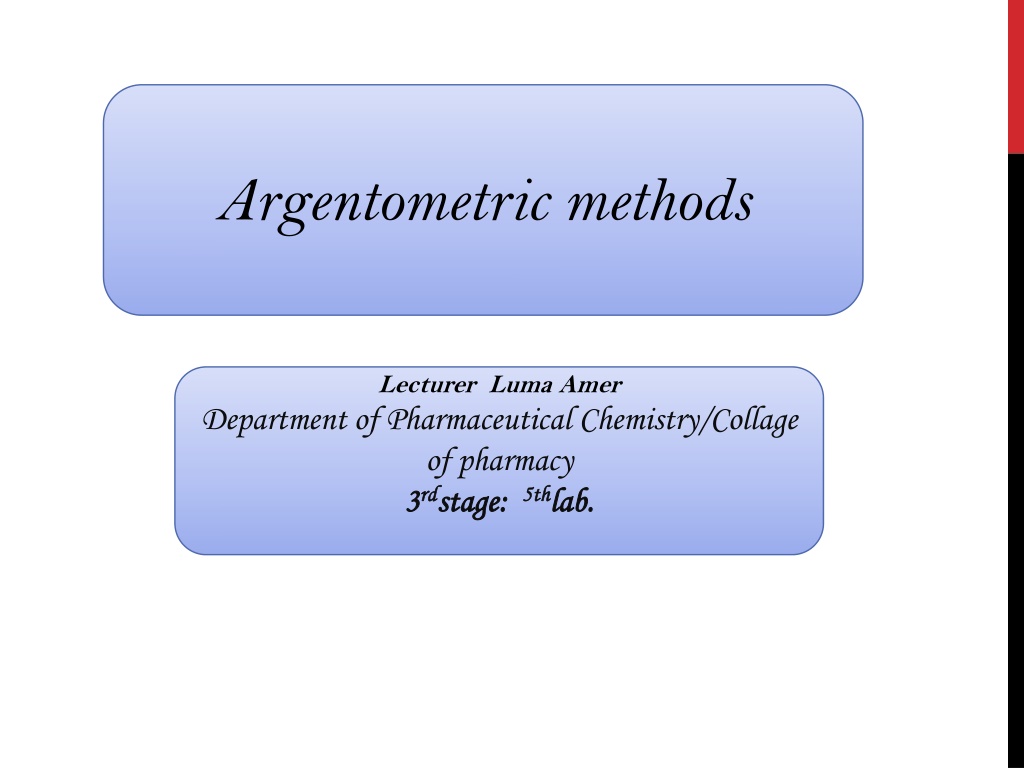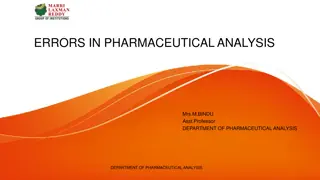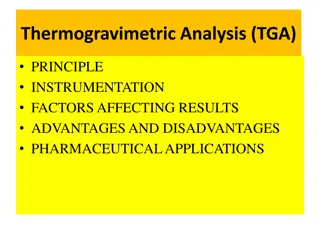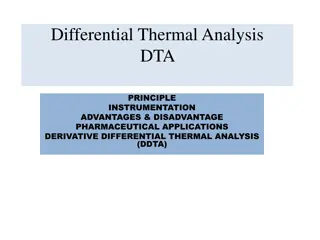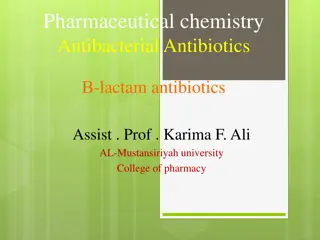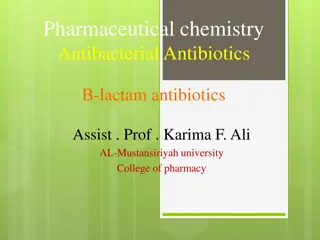Understanding Argentometric Methods in Pharmaceutical Chemistry
Argentometric methods, as taught by Lecturer Luma Amer from the Department of Pharmaceutical Chemistry at the College of Pharmacy, involve titrations using silver-based compounds like silver nitrate. These methods have limitations due to co-precipitation effects and limited indicator choices. Parameters for successful analysis include insoluble precipitates and rapid reactions. The M0hr's method and the Volhard's method are common approaches in argentometric titrations. Silver nitrate is a key reagent in these methods, known for its solubility and antibacterial properties. Proper handling and storage of silver nitrate are essential due to its corrosive nature.
- Argentometric Methods
- Pharmaceutical Chemistry
- Titration Techniques
- Silver Nitrate
- Chemical Analysis
Download Presentation

Please find below an Image/Link to download the presentation.
The content on the website is provided AS IS for your information and personal use only. It may not be sold, licensed, or shared on other websites without obtaining consent from the author. Download presentation by click this link. If you encounter any issues during the download, it is possible that the publisher has removed the file from their server.
E N D
Presentation Transcript
Argentometric methods Lecturer Luma Amer Department of Pharmaceutical Chemistry/Collage of pharmacy 3 3rd rdstage stage: : 5 5th thlab lab. .
It is, however, interesting to observe here that such reactions do offer limited usage because of the following facts: (i) Co-precipitation effects do not give a real composition of the precipitate. (ii) Choice of appropriate indicator is very much limited (iii) the solubility product that plays a major role in such titration. The solubility product constant, Ksp, is the equilibrium constant for a solid substance dissolving in an aqueous solution. It represents the level at which a solute dissolves in solution. The more soluble a substance is, the higher the Ksp value it has.
PARAMETERS THAT MAY BE CONSIDERED FOR A FEASIBLE ARGENTOMETRIC ANALYSIS ARE: 1-Precipitate formed must be insoluble. 2- Precipitation process should be fast and rapid. 3-Co- precipitation effects must be minimal. 4- Detection f equivalence point must be apparently visible. Assay methods : Argentometric titrations may be divided into two class: (i) Direct titration with silver-nitrate(M0hr's method). (ii) Ammonium thiocyanate-silver nitrate titrations (Volhard s Method).
SILVER NITRATE AgNO3 , M.Wt. 169.87 ,occurs as colorless or white crystals which omebec gray or grayish black on exposure to light , it is very soluble in water , sparingly soluble in alcohol and freely soluble boiling alcohol. Solution of silver nitrate in concentrations between 0.5N and 1N are used as antibacterial agents. Q: why silver nitrate is not a primary standard? Q: After prepare silver nitrate solution, who should you store it? Caution : silver nitrate is very corrosive , it never to be weighed on an analytical balance .it may damage the balance , it can also burn the skin and it is also expensive so do not waste it
SODIUM CHLORIDE A chemical compound with the formula NaCl .sodium chloride is the salt mot responsible for the salinity of the extracellular fluid of many multicellular organisms, it is commonly used as a condiment and food preservative Q: Can you consider NaCl as a primary standard compound or not ? sodium chloride white crystals, Odorless. Very slightly toxic by ingestion. Dust may cause minor irritation to mucous membranes upon inhalation. potassium chromate: Yellow crystals. Odorless. Known human carcinogen (IARC-1). Highly toxic by ingestion. Irritating to body tissues. Sensitizer. Avoid all body contact.
STANDARDIZATION OF SILVER NITRATE SOLUTION
PROCEDURE : 1- FROM HOOD NO.1 AND USING YOUR MEASURING CYLINDER TRANSFER 5ML OF 0.1 N NACL SOLUTIONS TO YOUR CONICAL FLASK. 2- FROM HOOD NO.1, ADD 1ML OF 5% POTASSIUM CHROMATE (K2CRO4) INDICATOR. 3- FILL THE BURETTE ABOUT 10 ML OF AGNO3 SOLUTION FROM HOOD NO.1 4- TITRATE AGAINST AGNO3 SOLUTION. NOTE: YOUR END POINT IS REACHED WHEN A BRICK RED PRECIPITATE IS REACHED. 4- COMPLETE YOUR CALCULATIONS.
0 10 AgNO3 solution 20 30 40 50 5 ml of 0.1 NaCl + 1 ml 5%K2CrO4
CALCULATIONS: 1- Calculate the Normality for AgNO3 . NV NaCl = NV AgNO3 2- calculate the Wt% for NaCl in your solution no.Eq. of NaCl = no.Eq. of AgNO3 1eq wt. NaCl 1eq wt. AgNO3 58.45 g/eq.NaCl (1000 ml) 1N AgNO3 / 1000 0.05845 g/eq. NaCl 1 ml 1N AgNO3 / 10 or *0.1N 0.005845 g/eq. NaCl 1 ml 0.1N AgNO3 W/ V %= wt. Practical / v Theoretical*100 wt. Practical= 0.005845 g/eq .* v (e.p.)
